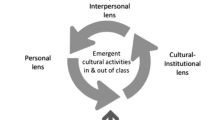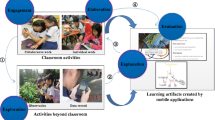Abstract
This paper adopts scenario planning as a methodological approach and tool to help science educators reconceptualise their use of mobile technologies across various different futures. These ‘futures’ are set out neither as predictions nor prognoses but rather as stimuli to encourage greater discussion and reflection around the use of mobile technologies in science education. Informed by the literature and our empirical data, we consider four alternative futures for science education in a mobile world, with a particular focus on networked collaboration and student agency. We conclude that ‘seamless learning’, whereby students are empowered to use their mobile technologies to negotiate across physical and virtual boundaries (e.g. between school and out-of-school activities), may be the most significant factor in encouraging educators to rethink their existing pedagogical patterns, thereby realizing some of the promises of contextualised participatory science learning.



Similar content being viewed by others
References
Alabri, A., & Hunter, J. (2010). Enhancing the quality and trust of citizen science data. In e-Science (e-Science), 2010 I.E. Sixth International Conference on (pp. 81–88). IEEE.
Aubusson, P., & Schuck, S. (2013). Teacher education futures: today’s trends, tomorrow’s expectations. Teacher Development, 17(3), 322–333. doi:10.1080/13664530.2013.813768.
Aubusson, P., Griffin, J., & Kearney, M. (2012). Learning beyond the classroom: implications for school science. In B. Fraser, K. Tobin, & C. McRobbie (Eds.), The second international handbook of science education (pp. 1123–1134). Netherlands: Springer.
Beauchamp, G., Burden, K., & Abbinett, E. (2015). Teachers learning to use the iPad in Scotland and Wales: a new model of professional development. Journal of Education for Teaching, 41(2), 161–179.
Burden, K., Hopkins, P., Male, T., Martin, S., & Trala, C. (2012). iPad Scotland evaluation. Faculty of Education, The University of Hull, UK. Retrieved 25 January 2016 from http://www.janhylen.se/wp-content/uploads/2013/01/Skottland.pdf
Cann, A. (2010). Scenario based strategic planning in the U.S. Army Corps of Engineers Civil Works Program, IWR White Paper, http://www.iwr.usace.army.mil/Portals/70/docs/iwrreports/Scenario-BasedStrategicPlanning.pdf
Cheng, K. H., & Tsai, C. C. (2013). Affordances of augmented reality in science learning: suggestions for future research. Journal of Science Education and Technology, 22(4), 449–462.
Cochrane, T., & Antonczak, L. (2014). Implementing a mobile social media framework for designing creative pedagogies. Social Sciences, 3(3), 359–377. doi:10.3390/socsci3030359.
Codd, J. A., Brown, M., Clark, J., Mcpherson, H., O’Neill, J., O’Neill, H., Waitere, A., & Zepke, N. (2002). Review of future-focused research on teaching and learning. Wellington: Ministry of Education New Zealand.
Crooks, C. (1999). Computers in the community of classrooms. In K. Littleton & P. Light (Eds.), Learning with computers. Analysing productive interaction (pp. 102–117). London: Routledge.
DeGennaro, D. (2012). Evolving learning designs and emerging technologies. In B. Fraser, K. Tobin, & C. McRobbie (Eds.), The second international handbook of science education (pp. 1319–1331). Netherlands: Springer.
Dunleavy, M., & Dede, C. (2014). Augmented reality teaching and learning. In J. M. Spector, M. D. Merrill, J. Elen, & M. J. Bishop (Eds.), Handbook of research on educational communications and technology (4th ed., pp. 735–745). New York: Springer.
Erstad, O., & Sefton-Green, J. (2012). Identity, community, and learning lives in the digital age. Cambridge University Press.
Foley, B. J., & Reveles, J. M. (2014). Pedagogy for the connected science classroom: computer supported collaborative science and the next generation science standards. Contemporary Issues in Technology and Teacher Education, 14(4). Retrieved from http://www.citejournal.org/vol14/iss4/science/article1.cfm.
Green, L., Hechter, R., Tysinger, P., & Chassereau, K. (2014). Mobile app selection for 5th through 12th grade science: the development of the MASS rubric. Computers & Education, 75, 65–71. doi:10.1016/j.compedu.2014.02.007.
Herodotou, C., Villasclaras-Fernández, E., & Sharples, M. (2014). The design and evaluation of a sensor-based mobile application for citizen inquiry science investigations. In Open Learning and Teaching in Educational Communities (pp. 434–439). Springer International Publishing.
Herreid, C. F., & Schiller, N. A. (2013). Case studies and the flipped classroom. Journal of College Science Teaching, 42(5), 62–66.
Ito, M., Baumer, S., Bittanti, M., Boyd, D., Cody, R., Herr-Stephenson, B., & Tripp, L. (Eds.). (2010). Hanging out, messing around, and geeking out: kids living and learning with new media. Cambridge, MA: MIT Press.
Johnson, L., Adams Becker, S., Estrada, V., & Martín, S. (2013). Technology outlook for STEM+ education 2013–2018: an NMC horizon project sector analysis. Austin, Texas: The New Media Consortium.
Jonassen, D. H., Carr, C., & Yueh, H. P. (1998). Computers as mindtools for engaging learners in critical thinking. TechTrends, 43(2), 24–32.
Jones, A. C., Scanlon, E., & Clough, G. (2013). Mobile learning: two case studies of supporting inquiry learning in informal and semiformal settings. Computers & Education, 61, 21–32.
Kamarainen, A. M., Metcalf, S., Grotzer, T., Browne, A., Mazzuca, D., Tutwiler, M. S., & Dede, C. (2013). EcoMOBILE: integrating augmented reality and probeware with environmental education field trips. Computers & Education, 68, 545–556.
Kearney, M., & Maher, D. (2013). Mobile learning in maths teacher education: driving pre-service teachers’ professional development. Australian Educational Computing, 27(3), 76–84.
Kearney, M., Burden, K., & Rai, T. (2015). Investigating teachers’ adoption of signature mobile pedagogies. Computers & Education, 80, 48–57.
Kearney, M., Schuck, S., Burden, K., & Aubusson, P. (2012). Viewing mobile learning from a pedagogical perspective. Research in Learning Technology, 20, 14406. doi:10.3402/rlt.v20i0/14406.
Kinash, S., Brand, J. & Mathew, T. (2012). Challenging mobile learning discourse through research: student perceptions of Blackboard Mobile Learn and iPads. Australasian Journal of Educational Technology, 28(4), 639–655. http://www.ascilite.org.au/ajet/ajet28/kinash.html
Krajcik, J. S., Blumenfeld, P., Marx, R. W., & Soloway, E. (2000). Instructional, curricular, and technological supports for inquiry in science classrooms. In J. Minstrell & E. H. Zee (Eds.), Inquiring into inquiry learning and teaching in science (pp. 283–315). Washington, DC: American Association for the Advancement of Science.
Lai, K. W., Khaddage, F., & Knezek, G. (2013). Blending student technology experiences in formal and informal learning. Journal of Computer Assisted Learning, 29(5), 414–425.
Ling, R., & Donner, J. (2009). Mobile communications. London: Polity.
Lui, M., Kuhn, A., Acosta, A., Niño-Soto, M. I., Quintana, C., & Slotta, J. D. (2014, April). Using mobile tools in immersive environments to support science inquiry. In CHI'14 Extended Abstracts on Human Factors in Computing Systems (pp. 403–406). ACM.
Marty, P. F., Alemanne, N. D., Mendenhall, A., Maurya, M., Southerland, S. A., Sampson, V., & Schellinger, J. (2013). Scientific inquiry, digital literacy, and mobile computing in informal learning environments. Learning, Media and Technology, 38(4), 407–428.
Mifsud, L. (2014). Mobile learning and the socio-materiality of classroom practices. Learning, Media and Technology, 39(1), 142–149.
Murray, O., & Olcese, N. (2011). Teaching and learning with iPads: ready or not? TechTrends, 55(6), 42–48.
Newman, G., Wiggins, A., Crall, A., Graham, E., Newman, S., & Crowston, K. (2012). The future of citizen science: emerging technologies and shifting paradigms. Frontiers in Ecology and the Environment, 10(6), 298–304.
Norris, C. A., & Soloway, E. (2011). Learning and schooling in the age of mobilism. Educational Technology, 51(6), 3–12.
OECD. (2001). Schooling for tomorrow, what schools for the future. Paris: OECD.
Pachler, N., Bachmair, B., & Cook, J. (2009). Mobile learning: structures, agency, practices. New York: Springer.
Park, Y. (2011). A pedagogical framework for mobile learning: categorizing educational applications of mobile technologies into four types. International Review of Research in Open and Distance Learning, 12(2), 78–102.
Parry, D. (2011). Mobile perspectives: on teaching mobile literacy. Educause Review, 46, 14–18.
Pecl, G., Gillies, C., Sbrocchi, C. & Roetman, P. (2015). Building Australia through citizen science. Office of the Chief Scientist. Occasional paper series. Issue 11 July, 2015. Retrieved 3 August 2015 from http://www.chiefscientist.gov.au/2015/07/occasional-paper-building-australia-through-citizen-science/
Peluso, D. (2012). The fast-paced iPad revolution: can educators stay up to date and relevant about these ubiquitous devices? British Journal of Educational Technology, 43, E125–E127. doi:10.1111/j.1467-8535.2012.01310.x.
Radinsky, J., Bouillion, L., Lento, E., & Gomez, L. (2001). Mutual benefit partnership: a curricular design for authenticity. Journal of Curriculum Studies, 33(4), 405–430.
Repetto, M. (2013). Networked informal learning and continuing teacher education. In G. Trentin & M. Repetto (Eds.), Using network and mobile technology to bridge formal and informal learning (pp. 183–207). Oxford: Chandos Publishing.
Royle, K., & Hadfield, M. (2012). From ‘posh pen & pad’ to participatory pedagogies: one story of a netbook implementation project with 108 pupils in two primary schools. International Journal of Mobile and Blended Learning, 4(1), 1–17.
Rushby, N. (2012). Editorial: an agenda for mobile learning. British Journal of Educational Technology, 43(3), 355–356. doi:10.1111/j.1467-8535.2012.01313.x.
Scanlon, E., Woods, W., & Clow, D. (2014). Informal participation in science in the UK: identification, location and mobility with iSpot. Journal of Educational Technology & Society, 17(2).
Schuck, S., & Aubusson, P. (2010). Educational scenarios for digital futures. Learning, Media and Technology, 35(3), 293–305. doi:10.1080/17439884.2010.509351.
Schuck, S., & Kearney, M. (2008). Classroom-based use of two educational technologies: a sociocultural perspective. Contemporary Issues in Technology and Teacher Education, 8(4). Retrieved 3rd August 2015 from http://www.citejournal.org/vol8/iss4/currentpractice/article2.cfm
Schuler, C., Winters, N., & West, M. (2012). The future of mobile learning: implications for policy makers and planners. Paris: UNESCO.
Schwartz, P. (1997). The art of the long view. Chichester: Wiley.
Sharples, M. (2013). Mobile learning: research, practice and challenges. Distance Education in China, 3(5), 5–11.
Sharples, M., Taylor, J., & Vavoula, G. (2007). A theory of learning for the mobile age. In R. Andrews & C. Haythornthwaite (Eds.), The SAGE handbook of e-learning research (pp. 221–224). London: Sage.
Shell. (2003). Scenarios: an explorer’s guide. London: Shell.
Snoek, M. (2005). Scenario writing in education. Teaching guidelines for an in-service course for teachers and teacher educators. Brussels/Amsterdam: Association for Teacher Education in Europe.
Snoek, M. (2013). From splendid isolation to crossed boundaries? The futures of teacher education in the light of activity theory. Teacher Development, 17(3), 307–321. doi:10.1080/13664530.2013.813758.
Snoek, M., Baldwin, G., Cautreels, P., Enemaerke, T., Halstead, V., Hilton, G., Klemp, T., et al. (2003). Scenarios for the future of teacher education in Europe. European Journal of Teacher Education, 26(1), 21–36.
Song, Y. (2014). “Bring Your Own Device (BYOD)” for seamless science inquiry in a primary school. Computers & Education, 74, 50–60.
Toh, Y., So, H. J., Seow, P., Chen, W., & Looi, C. K. (2013). Seamless learning in the mobile age: a theoretical and methodological discussion on using cooperative inquiry to study digital kids on-the-move. Learning, Media and Technology, 38(3), 301–318.
Traxler, J. (2009). Learning in a mobile age. International Journal of Mobile and Blended Learning, 1(1), 1–12.
Van Der Heijden, K. (2005). Scenarios: the art of strategic conversation. London: Wiley.
Van Gunsteren, H. R. (1976). The quest for control exemplar scenarios from science, engineering and maths. London: Wiley.
Wang, M., & Shen, R. (2012). Message design for mobile learning: learning theories, human cognition and design principles. British Journal of Educational Technology, 43(4), 561–575.
Wenger. (1998). Communities of practice: learning, meaning, and identity. Cambridge: Cambridge University Press.
Wilson, R., Goodman, J., Bradbury, L., & Gross, L. (2013). Exploring the use of iPads to investigate forces and motion in an elementary science methods course. Contemporary Issues in Technology and Teacher Education, 13(2). Retrieved from http://www.citejournal.org/vol13/iss2/science/article1.cfm.
Wong, L. H., & Looi, C. K. (2011). What seams do we remove in mobile-assisted seamless learning? A critical review of the literature. Computers & Education, 57(4), 2364–2381.
Zhang, B. H., Looi, C. K., Seow, P., Chia, G., Wong, L. H., Chen, W., So, H. J., Soloway, E., & Norris, C. (2010). Deconstructing and reconstructing: transforming primary science learning via a mobilized curriculum. Computers & Education, 55(4), 1504–1523. doi:10.1016/j.compedu.2010.06.016.
Zimmerman, H. T., & Land, S. M. (2014). Facilitating place-based learning in outdoor informal environments with mobile computers. TechTrends, 58(1), 77–83.
Author information
Authors and Affiliations
Corresponding author
Rights and permissions
About this article
Cite this article
Burden, K., Kearney, M. Future Scenarios for Mobile Science Learning. Res Sci Educ 46, 287–308 (2016). https://doi.org/10.1007/s11165-016-9514-1
Published:
Issue Date:
DOI: https://doi.org/10.1007/s11165-016-9514-1




